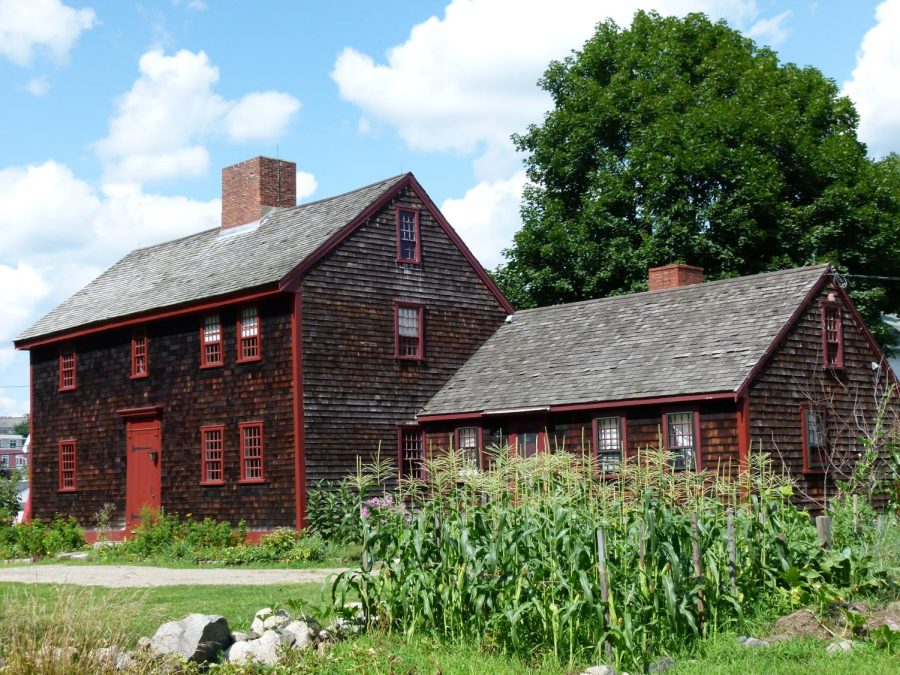The History of a Historian
Meet one of Reading’s principal historians
January 8, 2022
Residents of Reading may know bits and pieces of our town’s history, from the town’s origins before the United States even existed, to Joshua Eaton and the Parker Tavern. More modern events, such as the decommissioned Nike Ajax Missile Sites on Bear Hill and what is now Burbank Ice Arena, to an abhorrent act directed at Celtics legend Bill Russell when he lived in town, may also be familiar to some. However, you may not know the man who ties all these events together.
Reading historian Everett Blodgett has been at the forefront of researching Reading history. He has written two books, Reading: Images of America, and At Wood End: Massachusetts 1644 – 1994 for the 375th and 350th celebrations of Reading, respectively. I spoke with Mr. Blodgett for a conversation about his experience researching and publishing two books on the history of Reading, Massachusetts.
Mr. Blodgett, a 13th generation American, has lived in Reading for nearly 40 years, yet his ties to the town stretch back across many generations. Mr. Blodgett began teaching Chemistry at RMHS in 1970, but did not move to Reading until 12 years later. It was around this time when he began researching more about Reading history, specifically genealogy. He found that his ancestors had lived in this area when the town was incorporated in 1644. Back then, the land of Reading encompassed all of what is now North Reading and Wakefield. Mr. Blodgett also just recently discovered that he is related to Susanna North, one of the women involved with the Salem Witch Trials. North’s family lived in what is now North Reading. You can even see his family ties in Reading today. Prescott Street was named for one of Mr. Blodgett’s ancestors, Joshua Prescott, who was his 5th Great Grandmother’s brother.
The process of finding and cataloging Reading’s history was no easy feat. “I started accumulating [information on Reading history] and all of a sudden I accumulated a little bit more,” said Mr. Blodgett. When he was first starting out, computers and other modern technologies were obviously not part of the equation. Everything had to be searched for, either in real life or in a book at the library. This was no bother to Mr. Blodgett, “I’m quite visual and quite hands-on so therefore I like to hunt for things, find things, look at architecture, know who lived in a house, you know that sort of stuff, and it all pieces together,” he said. “The internet has made so many changes, for example, Find A Grave, or [being able to] find the history of a house or the history of an event.” Once historical records became more available online, researching history became much easier and more accessible to people.
As one of the premier historians in Reading, Mr. Blodgett’s research has unearthed a lot of interesting information. Take for instance the 2 foot by 3 foot large map of Reading dated back to 1795 found by Mr. Blodgett and his wife while researching for his book, Reading: Images of America. For a long time, they believed that the map was truly 200 years old until it was later discovered that it was printed on a type of paper called Queen’s Paper, which did not exist until 1863. Evidence of pinholes in the paper led them to believe that the map was pinned down and traced onto the paper sometime in the late 1800s. Due to the size and quality of paper used, the map would have been very expensive to reproduce. This was thought to be one of the oldest artifacts from Reading’s history until it was dethroned by a recent discovery. A set of fifteen arrowheads from a farm in Reading were discovered by Mr. Blodgett in New Hampshire. These arrowheads were dug up in the 1940s and brought to the Granite State by a woman who lived in Reading. The artifacts dated back to well before the 1600s and the founding of Reading. This notable discovery is part of Reading’s indigneous history and will soon be on display at Parker Tavern.
According to Mr. Blodgett, one part of Reading’s history that is often overlooked by Reading residents is Parker Tavern. “I think Parker Tavern is not given it’s due,” he said. It is a First Period house, which means it was built before 1725. The fact that there is a building older than the country that is still standing in Reading is astounding. There is so much history associated with the house. One of the most notable examples is how the tavern served as a prison for one of the most famous prisoners of the American Revolution, Archibald Campbell. Campbell was a British military officer who was captured at Boston Harbor in 1776. He was held here in Reading for two years until he was released in exchange for Ethan Allen, the famed American Revolution Patriot and one of the founders of Vermont. Campbell later served as the Governor of Jamaica, and is buried at Westminster Abbey in London, England.
When Mr. Blodgett set out to research Reading history; he had a goal. “I’ve tried to make history available to people,” said Mr. Blodgett, and he has indeed. His work over the past 40 years has opened up more people to the historical events that shaped their hometown. The books he has published have revealed how life used to be here. The discoveries he has made have been a great benefit to the residents of Reading and our understanding of what occurred here before us.
